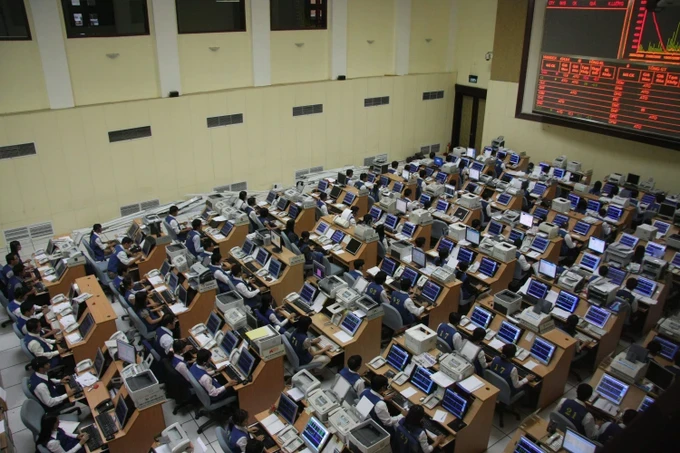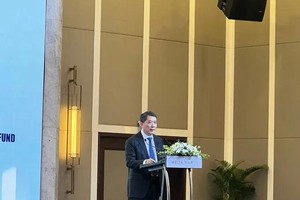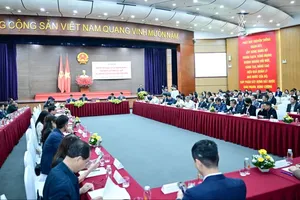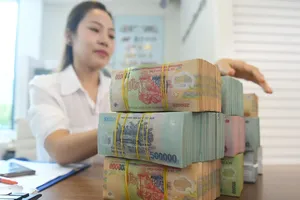
July 2000 marked a watershed moment with the official launch of the HCMC Securities Trading Center – the precursor to the modern HCMC Stock Exchange (HOSE). This institution heralded the arrival of Vietnam’s first centralized stock exchange.
The inaugural trading session on July 28, 2000, featured the debut of just two stocks: REE (Refrigeration Electrical Engineering Corporation) and SAM (Saigon Cable and Telecom Material JSC). This seemingly modest start signaled a profound turning point, ushering in a new era for Vietnam’s economic trajectory in general and the promising securities industry in particular.
During its initial year of operation, HOSE listed a mere five stocks and four bonds. Fast forward to the close of 2024, and the transformation is staggering. HOSE’s stock market capitalization has soared from a modest VND1 trillion (US$38.9 million), representing less than 1 percent of GDP, to an impressive VND5.2 quadrillion ($202.2 billion), now accounting for a substantial 50.95 percent of the nation’s economic output.
Investor Thuy Tien from District 1 of HCMC vividly recalls the early 2000s stock market, an entirely contrast to today’s digital ease. Back then, with a mere five listed stocks, placing buy or sell orders involved painstakingly handwritten slips and often lengthy waits for manual processing by brokerage staff. Trading was limited to just three days a week, two hours per day, with single daily matching at 11:00 a.m. The current reality of instant, high-volume online trading for millions of shares was utterly unimaginable in those rudimentary beginnings.
Over 25 years, HOSE has meticulously constructed the nation’s largest centralized stock market, attracting the listing of the economy’s leading enterprises and firmly establishing its pivotal role within Vietnam’s securities market. It has successfully transformed the stock market into a vital and efficient channel for capital mobilization, effectively catalyzing the equitization process and providing crucial support for the nation’s economic restructuring initiatives.
During the 2010-2015 economic restructuring phase, the volume of capital raised by companies listed on HOSE witnessed a remarkable fivefold increase compared to the 2004-2009 period. An impressive over 80 percent of HOSE-listed companies significantly augmented their charter capital, ranging from more than tenfold to nearly fiftyfold, including prominent entities such as Vincom (VIC), Vietcombank (VCB), Refrigeration Electrical Engineering Corporation (REE), and Vinamilk (VNM).
The capital channeled through the stock market has empowered these enterprises to bolster their financial strength, invest in ambitious new projects, expand their production and business operations, and enhance their overall competitiveness and operational efficiency.
Since 2005, HOSE has facilitated over 550 enterprise share auctions, notably including 350+ IPOs for state-owned firms undergoing equitization. Landmark auctions of Sabeco, Vietcombank, and Vinamilk generated substantial capital. This equitization and subsequent listing encourage autonomy, agility, transparency, and better governance, ultimately enhancing the competitiveness of these once state-controlled entities.
However, the stock market’s journey has not been without its ups and downs. Commencing at a base of 100 points, the VN-Index experienced a period of rapid and arguably overheated growth, peaking at 1,170.76 points in late 2007, before a sharp reversal saw it plummet to a low of 235 points in 2009. It took nearly a decade for the VN-Index to reclaim the 1,200-point mark in 2018, subsequently experiencing persistent fluctuations around this level.
The market then absorbed the shockwaves of the Covid-19 pandemic, with the VN-Index retreating to 649 points in March 2020. This was followed by a fresh wave of investment fueled by the “cheap money” environment resulting from accommodative monetary policies designed to support the struggling economy, propelling the VN-Index to 1,300, then 1,400, and ultimately reaching a high of 1,500 points in late 2021 and early 2022, before settling back around the 1,000-point mark.
During this period of intense activity, HOSE’s trading system faced significant overload, leading to frequent order congestion issues. Currently, HOSE is utilizing software provided by FPT from the Hanoi Stock Exchange while awaiting the deployment of a more robust and future-proof system.
More seriously, over the years, numerous incidents of market manipulation involving entities such as FLC, the Louis ecosystem, Tri Viet, Apec, Tan Hoang Minh, and Van Thinh Phat have inflicted substantial losses on investors. However, regulatory authorities have responded with stricter enforcement measures aimed at bolstering market transparency and integrity. Many individuals involved in illicit activities such as manipulation and profiteering on the stock market have been brought to justice, with the goal of steering Vietnam’s stock market back onto a path of more stable and sustainable growth.
HOSE Capitalization Milestones:
- Year 2000: VND 1 trillion ($38.9 million)
- Year 2005: VND 7.4 trillion ($287.8 million)
- Year 2010: VND 591.3 trillion ($23 billion)
- Year 2015: VND 1.146 quadrillion ($44.6 billion)
- Year 2020: VND 4.08 quadrillion ($158.7 billion)
- Year 2024: VND 5.2 quadrillion ($202.2 billion)
- February 2025: VND 5.44 quadrillion ($211.6 billion)
The upward trend in HOSE’s listed securities continues, accompanied by increasingly sophisticated trading methods and more timely information for a growing number of domestic and international investors. Beyond traditional stocks, HOSE now offers ETFs, bond fund, balanced fund, and retirement fund, expanding investor choices. This has attracted diverse investment funds, driving the total assets under management in Vietnam beyond VND600 trillion (approximately $25 billion).
Acting Chairwoman Nguyen Viet Ha of HOSE highlighted that the VN-Index closed 2024 at 1,266.78 points, marking a significant 12.11 percent increase compared to 2023, ranking third regionally behind Singapore and Malaysia. The liquidity of the Vietnamese stock market reached an average of VND18.7 trillion ($727.3 million) per day, a substantial 22.4-percent increase year-on-year, placing it third in the region after Thailand and Singapore.
Notably, in March 2025, the VN-Index decisively surpassed the 1,300-point mark, with market liquidity in numerous recent sessions exceeding VND20 trillion ($778 million) per session, representing a robust 20-to-30-percent rise compared to the average of the same period in the preceding year.
Vietnam’s maturing stock market has become a popular investment choice, drawing in millions of domestic and international investors. By February 2025, it reached 9.5 million individual accounts, about 9.5 percent of the population, surpassing the 2025 target of the Stock Market Development Strategy to 2030 and aiming for 11 million by 2030. This growth underscores the market’s increasing accessibility and appeal to a broad investor base.
Acting Chairwoman Nguyen Thi Viet Ha highlights 2025 as a pivotal year, marking HOSE’s 25th anniversary. Looking ahead, HOSE is dedicated to leveraging past achievements by actively implementing key strategies, including launching a new, advanced IT system. This initiative aims to introduce innovative products and services, positioning the market for a potential upgrade, ultimately enhancing capital supply, fostering stronger market development, and elevating Vietnam’s financial market globally.










)

)











